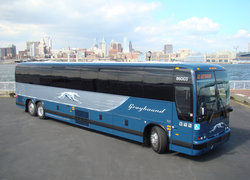
Top Frequently Asked Questions on DEF
Product News Wednesday, October 10, 2012: Cooper Petroleum Inc
Cooper Petroleum has many solutions for your SCR and DEF needs. Get information on the detailed product data, pricing and ordering today!
Please complete the Contact Form located on the side of this page and we will respond to you promptly.
Also, feel free to call us: 1-888-652-5635.
Original text and image found here.
Everything a bus operator needs to know about Diesel Exhaust Fluid and Selective Catalytic Reduction.
By American Bus Association staff
Meeting 2010 U.S. EPA diesel emissions regulations requires a process to cut emissions of nitrogen oxide (NOx), hydrocarbons (HC) and particulate matter (PM). The method of preference is Selective Catalytic Reduction (SCR) via a catalyst that injects small amounts of watery Diesel Exhaust Fluid (DEF) or urea through a nozzle into the emission control systems, cutting cuts emissions of NOx by 75 to 90 percent, HC by up to 80 percent, and PM by up to 30 percent. The fluid then vaporizes into ammonia, carbon dioxide and water.
What exactly are urea and diesel exhaust fluid?
Urea is a nitrogen compound that when heated becomes klm ammonia, used to make plastics, fertilizer and adhesives. Urea used expressly for SCR in advanced modern diesel systems is very pure. DEF is one-third pure urea and two-thirds pure water. SCR system functions at its best when the fluid is injected into the exhaust stream at extremely high temperatures above 200° C.
Is DEF safe to handle?
DEF is safe to work with and store, and poses no serious risk to humans when handled properly. It is colorless, non-toxic, non-hazardous, nonflammable and non-polluting. DEF can damage carbon steel, copper, brass, aluminum and lower-grade plastics.
How is DEF pumped into the correct tank?
DEF dispensers have a specially designed nozzle. DEF tank caps have a distinctive blue color. Pump DEF only in a designated DEF tank and use only dedicated DEF equipment when handling and dispensing the fluid. Always keep DEF dspensing equipment clean and free from dust or dirt. Do not add DEF to fuel, oil and coolant, or any other other tanks on the vehicle. Do not pump DEF directly into a diesel tank or vice-versa. Do not add water or other substances such as anti-gelling solutions or anti-freeze to DEF.
What happens if DEF gets into a wrong tank or spills?
The catalyst will recognize any non-DEF solution, in which case a dashboard indicator light will flash, notifying the driver. The vehicle could require servicing, such as draining and cleaning the tank. If DEF is spilled on the ground or on pavement, absorb the spilled liquid with a non-combustible absorbent such as sand. If DEF is spilled on your vehicle, rinse with water by about 7 percent. DEF tanks are designed to accommodate this expansion. DEF thaws quickly, and even if it freezes when the motorcoach is not operating, start-up and normal operation of the vehicle will not be affected. When the engine is running, the vehicle coolant system heats the DEF tank and supply lines, and vehicle operation can continue normally. If the storage temperature for DEF doesn’t exceed 75º F, shelf life will be two years. Keeping lids properly secured to DEF containers is essential to ensuring maximum DEF shelf life.
What are the storage capacities for DEF?
Depending on the manufacturer, bulk storage options include 275- and 330-gallon disposable totes, 55-gallon plastic drums, as well as one-to-five-gallon containers.
How much DEF is required at one time? What if it runs out during a trip?
As DEF is injected only when needed, the SCR system puts less strain on the engine and can contribute to increased fuel efficiency. A motorcoach getting typical fuel economy will be able to travel more than 225 miles on a single gallon of DEF. Expect DEF to account for 2 percent of fuel consumption, depending on duty cycles and loads. Dashboard warning lamps will alert the driver when DEF is low.
If the vehicle has run completely out of DEF, vehicle power will be reduced enough to encourage the driver to refill the DEF tank. Once the tank has been refilled, the engine will resume normal power levels. Error codes will be logged into the computer.
What are the effects of DEF on service and maintenance?
Manufacturer requirements vary. Some require no change to normal service routines, or minor adjustments during which the DEF filter can be changed in minutes. Other manufacturers vary by model. Consult your local customer support representative.
How much will DEF cost?
DEF is expected to cost almost the same as ultra-low sulfur diesel fuel on a per-gallon basis. As more new systems are sold and fleets turnover, costs should drop.
Can I buy a new 2010 EPA engine with SCR and install it in an older bus?
Clean-air emissions retrofit products are being verified by both U.S. EPA and the California Air Resources Board. Unlike the reduction of PM, HC and CO, reducing NOx requires the use of a catalyst that needs either urea or diesel fuel to be injected across the catalyst, thereby increasing the complexity of the system required for NOx control, and thus the entire diesel system of the coach. So it is not a matter of a simple swap-out.
Original text and image found here.
